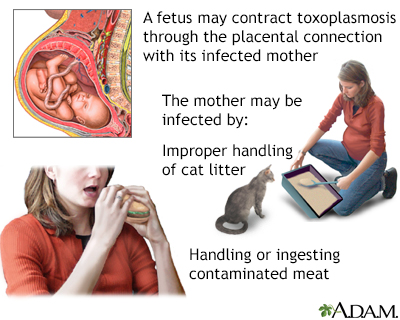Congenital toxoplasmosis
Congenital toxoplasmosis is a group of symptoms that occur when an unborn baby (fetus) is infected with the parasite Toxoplasma gondii.
Images

I Would Like to Learn About:
Causes
Toxoplasmosis infection can be passed to a developing baby if the mother becomes infected while pregnant. The infection spreads to the developing baby across the placenta. Most of the time, the infection is mild in the mother. The woman may not be aware she has the parasite. However, infection of the developing baby can cause serious problems. Problems are worse if the infection occurs in early pregnancy.
Symptoms
Up to half babies who become infected with toxoplasmosis during the pregnancy are born early (prematurely). The infection can damage the baby's eyes, nervous system, skin, and ears.
Often, there are signs of infection at birth. However, babies with mild infections may not have symptoms for months or years after birth. If not treated, most children with this infection develop problems in their teens. Eye problems are common.
Symptoms may include:
- Enlarged liver and spleen
- Vomiting
- Eye damage from inflammation of the retina or other parts of the eye
- Feeding problems
- Hearing loss
- Jaundice (yellow skin)
- Low birth weight (intrauterine growth restriction)
- Skin rash (tiny red spots or bruising) at birth
- Vision problems
Brain and nervous system damage ranges from very mild to severe, and may include:
- Seizures
- Intellectual disability
Exams and Tests
The health care provider will examine the baby. The baby may have:
- Swollen spleen and liver
- Yellow skin (jaundice)
- Inflammation of the eyes
- Fluid on the brain (hydrocephalus)
- Swollen lymph nodes (lymphadenopathy)
- Large head size (macrocephaly) or smaller-than-normal head size (microcephaly)
Tests that may be done during pregnancy include:
After birth, the following tests may be done on the baby:
- Antibody studies on cord blood and cerebrospinal fluid
- CT scan of the brain
- MRI scan of the brain
- Neurological exams
- Standard eye exam
- Toxoplasmosis test
Treatment
Spiramycin can treat infection in the pregnant mother.
Pyrimethamine and sulfadiazine can treat a fetal infection (diagnosed during the pregnancy).
Treatment of infants with congenital toxoplasmosis most often includes pyrimethamine, sulfadiazine, and leucovorin for one year. Infants are also sometimes given steroids if their vision is threatened or if the protein level in the spinal fluid is high.
Outlook (Prognosis)
The outcome depends on the extent of the condition.
Possible Complications
Complications may include:
- Hydrocephalus
- Blindness or severe visual disability
- Severe intellectual disability or other neurological problems
When to Contact a Medical Professional
Contact your provider if you are pregnant and think you are at risk for the infection. (For example, toxoplasmosis infection can be passed from cats if you clean the cat's litter box.) Contact your provider if you are pregnant and have not had prenatal care.
Prevention
Women who are pregnant or planning to become pregnant can be tested to find out if they are at risk for the infection.
Pregnant women who have cats as house pets may be at higher risk. They should avoid contact with cat feces, or things that could be contaminated by insects exposed to cat feces (such as cockroaches and flies).
Also, cook meat until it is well done, and wash your hands after handling raw meat to avoid getting the parasite.
Related Information
ToxoplasmosisIntrauterine growth restriction
Enlarged liver
Anemia
Bleeding into the skin
Retina
Blindness and vision loss
References
Duff WP. Maternal and perinatal infection in pregnancy: bacterial. In: Landon MB, Galan HL, Jauniaux ERM, et al, eds. Gabbe's Obstetrics: Normal and Problem Pregnancies. 8th ed. Philadelphia, PA: Elsevier; 2021:chap 58.
McLeod R, Boyer KM. Toxoplasmosis (Toxoplasma gondii). In: Kliegman RM, St. Geme JW, Blum NJ, Shah SS, Tasker RC, Wilson KM, eds. Nelson Textbook of Pediatrics. 21st ed. Philadelphia, PA: Elsevier; 2020:chap 316.
Montoya JG, Boothroyd JC, Kovacs JA. Toxoplasma gondii. In: Bennett JE, Dolin R, Blaser MJ, eds. Mandell, Douglas, and Bennett's Principles and Practice of Infectious Diseases. 9th ed. Philadelphia, PA: Elsevier; 2020:chap 278.
BACK TO TOPReview Date: 4/28/2023
Reviewed By: Neil K. Kaneshiro, MD, MHA, Clinical Professor of Pediatrics, University of Washington School of Medicine, Seattle, WA. Also reviewed by David C. Dugdale, MD, Medical Director, Brenda Conaway, Editorial Director, and the A.D.A.M. Editorial team.

Health Content Provider
06/01/2025
|
A.D.A.M., Inc. is accredited by URAC, for Health Content Provider (www.urac.org). URAC's accreditation program is an independent audit to verify that A.D.A.M. follows rigorous standards of quality and accountability. A.D.A.M. is among the first to achieve this important distinction for online health information and services. Learn more about A.D.A.M.'s editorial policy, editorial process and privacy policy. A.D.A.M. is also a founding member of Hi-Ethics. This site complied with the HONcode standard for trustworthy health information from 1995 to 2022, after which HON (Health On the Net, a not-for-profit organization that promoted transparent and reliable health information online) was discontinued. |
The information provided herein should not be used during any medical emergency or for the diagnosis or treatment of any medical condition. A licensed medical professional should be consulted for diagnosis and treatment of any and all medical conditions. Links to other sites are provided for information only -- they do not constitute endorsements of those other sites. © 1997- 2025 A.D.A.M., a business unit of Ebix, Inc. Any duplication or distribution of the information contained herein is strictly prohibited.
